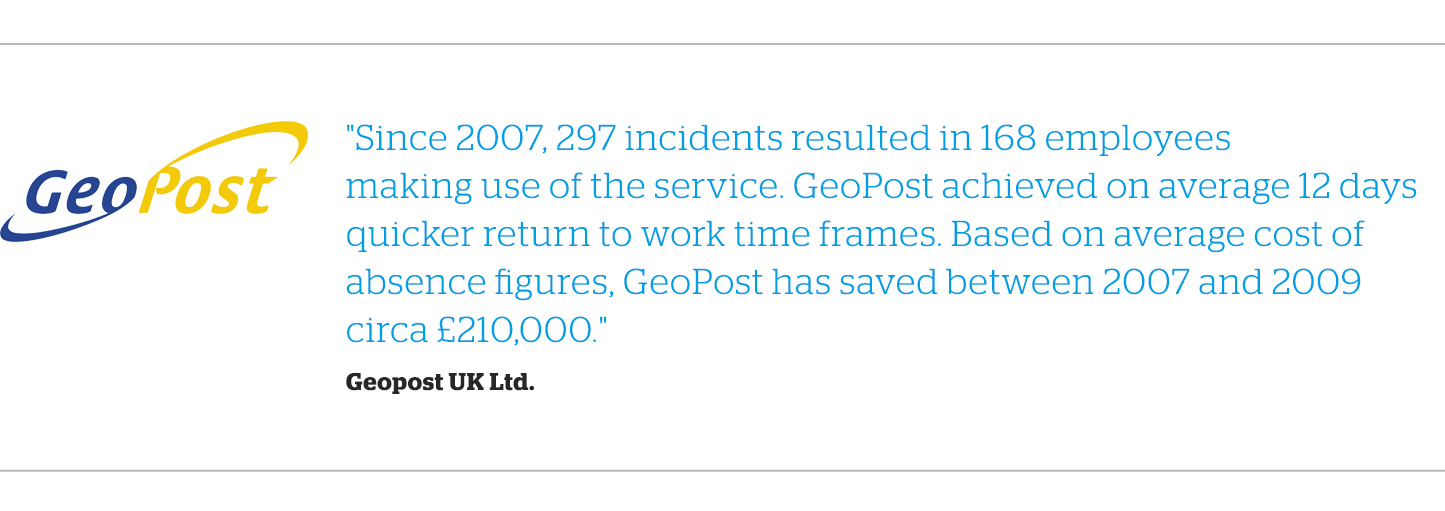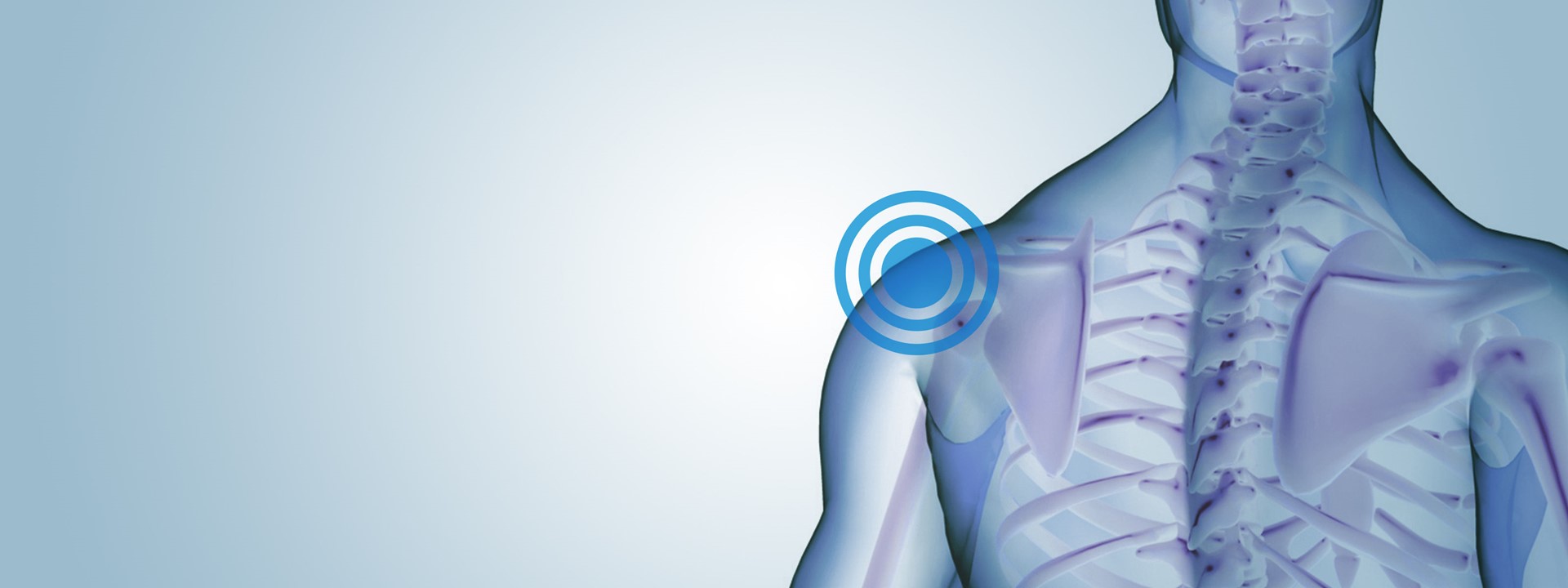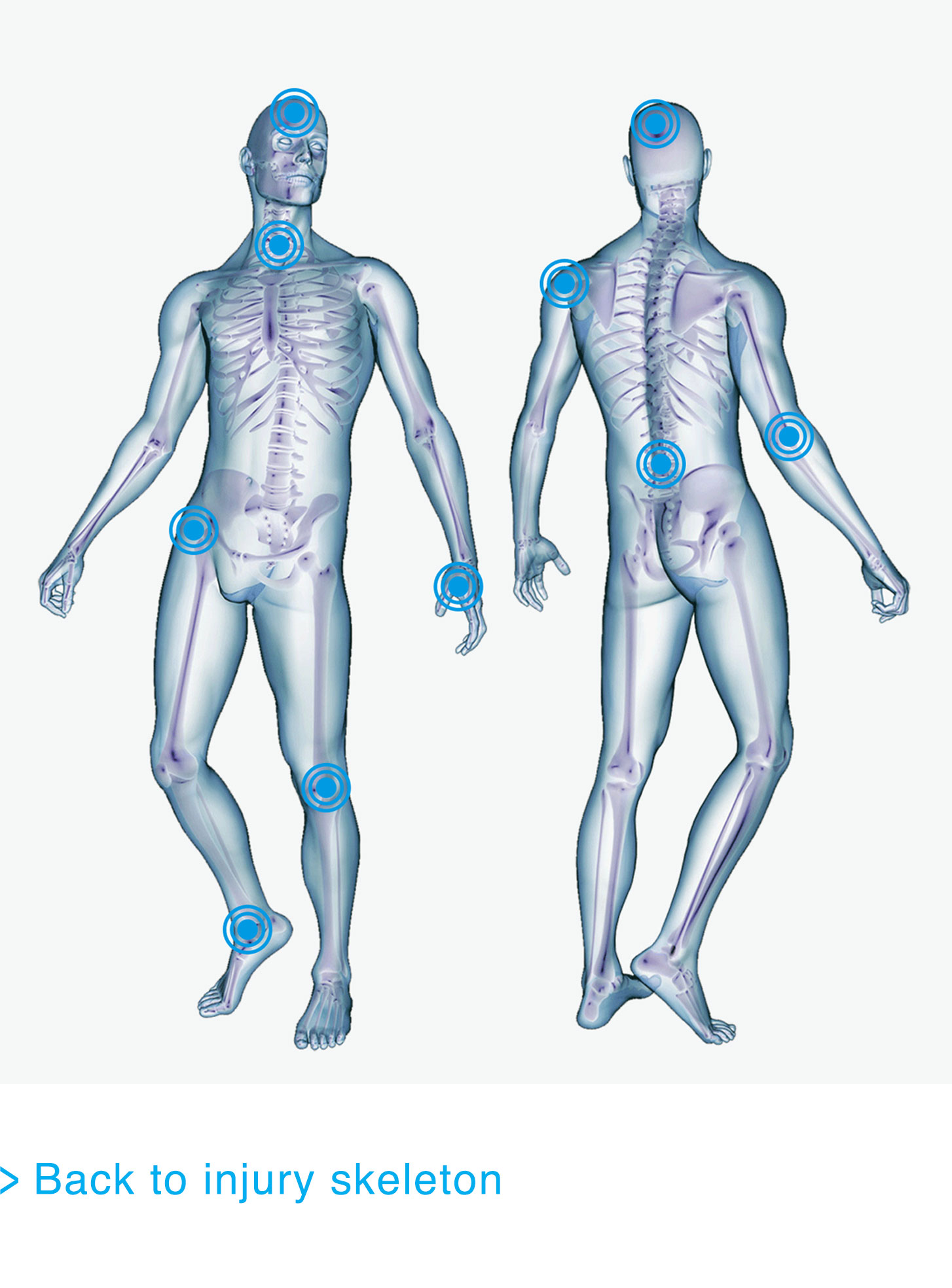The shoulder is an inherently unstable joint as it sacrifices stability for a greater range of movement and relies on a group of muscles called the rotator cuff to hold it in place. The rotator cuff is composed of four different muscles.
Fascinating facts
- When you move your arm, it is not just your shoulder joint that moves – your shoulder blade also moves. Without your shoulder blade moving, you would not be able to reach your arm all the way above your head.
- The fastest time taken to carry a car 20m strapped to the shoulders is 14.44 seconds and was achieved by Zydrunas Savickas of Lithuania in Italy in 2011. The car was stripped of much of its interior and weighed 397kg.

Related injuries
The clavicle is the only bony link between the shoulder and the body itself, in addition it provides protection to important underlying blood vessels and nerves. A clavicle fracture is sustained by a direct blow to the clavicle, such as in a fall or kick from a horse. Fractures to the clavicle lead to symptoms such as pain, swelling, nausea and reduced range of movements in the shoulder.
Occurrence/Frequency of Injury
It is a frequent injury in contact sports (rugby, martial arts) and impact sports (such as horse and motor racing). Clavicle fractures make up 5% of all fractures, so are not uncommon. The occurrence is 60 in 100,000 each year and is more common among men than women.
Treatment and Recovery Timeframes
Firstly, an X-ray is required to diagnose the fracture. Depending on the state of the fracture, conservative or surgical treatment is required:
- Conservative treatment will require the arm to be in a sling for 4-6 weeks to prevent shoulder range of movement and to allow the fracture to unite although in some cases complete union can take up to six months.
- Surgical treatment will be considered if non-union is present despite conservative treatment or if the fracture is deemed significant to warrant this approach. Surgery will involve internal fixation to assist in the union process.
As with any fracture, physiotherapy may assist, providing it is in line with medical precautions. Physiotherapy is generally focused on maintaining range of movement of the shoulder which is reduced by the fracture itself or through immobilisation of the joint when in a sling.
When returning to work, medical guidance should be sought. However, if returning to a non-manual position, an injured party could return after 4-6 weeks. For medium manual positions, a return to full duties should only be considered after union has occurred so generally, this is after approximately six weeks for non-complicated fractures. For heavy manual workers, specific advice should be sought from the treating consultant and an appropriate and graded return to work should be planned.
Interesting Facts
Famous people who have sustained this injury include 'Iron Man' Ozzy Osbourne but perhaps the most famous fractured collarbone occurred in 2005 when Madonna was thrown off a horse.
Frozen Shoulder is the common phrase used to describe 'adhesive capsulitis', which arises from shoulder inflammation that causes thickening of the shoulder capsule leading to a reduction in range of movement, pain and loss of function.
Occurrence/Frequency of Injury
Most of the time there is no known reason why people develop a Frozen Shoulder as it suddenly develops without any discernable cause. We do know it can happen if there is a period of immobility such as a complication of a fracture and that diabetics are more likely to suffer from one. Frozen Shoulders will normally develop in three stages:
Stage 1
During stage one, often referred to as the 'freezing' phase, the shoulder will start to ache and become very painful when reaching. (This stage may often last 2-9 months).
Stage 2
Stage two is often known as the 'frozen' phase. The shoulder may become increasingly stiff, but the pain does not usually get worse and may even decrease. (This stage can last between 4-12 months).
Stage 3
Stage three is called the 'thawing' phase and during this period, movement in the shoulder is gradually regained. (Stage three can last five months and, on occasion, several years.)
Treatment and Recovery Timeframes
Treatment for a Frozen Shoulder will vary depending on the stage of the condition and the severity of the pain and stiffness but recovery is often slow and may take 18-24 months.
Early stages
- The first stage of a Frozen Shoulder is the most painful, therefore treatment is mainly focussed on relieving the pain and keeping the shoulder joint as pain free and mobile as possible.
- Corticosteroid injections can help relieve pain and improve the movement in the shoulder for those with severe issues.
- Having too many corticosteroid injections can damage a shoulder, so this type of treatment may only be administered up to three times.
Later Stages
- After the initial, painful stage, stiffness is the main symptom of a Frozen Shoulder and a referral to a physiotherapist for shoulder exercises will assist.
Other interventions
It is unusual to need surgery for a Frozen Shoulder but it may be recommended if the symptoms are severe. Two possible surgical procedures which can be carried out:
Manipulation - During the procedure, the shoulder will be moved in a controlled way and stretched while under a general anaesthetic.
Arthroscopic capsular release - is an alternative procedure to manipulation. It is a type of keyhole surgery and only requires a small incision usually less than 1cm long. A special probe is used to open up the contracted shoulder capsule and remove any bands of scar tissue that have formed in the shoulder capsule, which should greatly improve symptoms. Following a manipulation and after having arthroscopic capsular release surgery physiotherapy will be required to restore the joint's normal range of movement.
Interesting Facts
People between 40 and 60 years of age are most prone to this condition and women tend to be more affected then men. It is interesting to note that no other joint in the body undergoes this same process. The good news is that Frozen Shoulders are often self limiting, meaning if left alone they generally heal themselves given time...a lot of time.
The rotator cuff (RC) is made up of a group of four muscles (the subscapularis, supraspinatus, infraspinatus and teres minor) and their tendons. They help keep the shoulder joint stable and also help with shoulder joint movement. On top of the shoulder joint is a bony process called the acromion. In the gap between the shoulder joint and the acromion is a narrow space where the rotator cuff tendons have to pass through and is a common site of injury.
Common Injuries to the RC include tendon tears and impingement as well as inflammation of the bursa (burstitis). All result in pain and reduced range of movement, which all reduce the function of the upper limb.
Occurrence/Frequency of Injury
Rotator cuff injuries are the most common type of shoulder injury in the UK. Injury often occurs through lifting heavy weights, repetitive use of arms, or through trauma from slipping and falling or being hit. Posture can also play a big part and people with a rounded shoulder posture or more likely to develop a Rotator Cuff Injury.
Treatment and Recovery Timeframes
The quicker the injury is diagnosed and treated the better the outcome. In order to gain a definitive diagnosis, an ultrasound or MRI scan will be required. Once diagnosed, depending on the severity of injury, options include:
- Rest, anti-inflammatory medications and pain relief
- Steroid injections which can be managed by a GP
- Physiotherapy to work on shoulder mobility and strength and to reduce pain
- Surgery for serious RC conditions. Commonly this is done as a shoulder arthroscopy (key hole surgery) and will be done to repair any damaged tendons or to correct an impingement.
Following surgery, physiotherapy is vital to the recovery. Following a period of immobilisation, treatment should be focused on maximising the range of movement in the shoulder.
Recovery from shoulder surgery can take several months of rehabilitation and require commitment from the injured party. Physiotherapy can be complimented by a structured gym programme.
During the rehabilitation stage, heavy lifting and forceful movements of the shoulder should be avoided and a return to these types of activities will be guided by the physiotherapist involved.
Interesting Facts
- People over the age of 30 who are doing repetitive type work are more likely to be at risk of rotator cuff injuries so it is prudent for employers to vary work activities.
- Mild tears to the RC can repair themselves; it's the severe tears that often result in a reduced range of movement that sometimes require surgery.
- Surgery results for repairing RC tears are hit and miss unfortunately, but the younger you are, the greater chance of success.
The shoulder is an inherently unstable joint as it sacrifices stability for a greater range of movement and relies on a group of muscles called the rotator cuff to hold it in place. The lack of stability means the shoulder is prone to dislocation or subluxation. A dislocation is when the head of the humerus moves out of the joint of the shoulder blade. Dislocations require admissions to A+E and the shoulder has to be re-located back into position.
A shoulder subluxation is similar to a Shoulder Dislocation, the difference being that a subluxation is temporary and partial e.g. someone may dislocate their shoulder temporarily but it goes back in place of its own accord.
The shoulder joint most commonly dislocates out to the front, but it can also dislocate out to the back or below.
Occurrence/Frequency of Injury
Shoulder Dislocations and subluxations normally occur in contact sports such as rugby and wrestling. However they can occur in instances where significant external forces are applied to the shoulder i.e. such as falling on an outstretched hand or a dog pulling strongly on its lead.
Unfortunately there is a very high incidence of injury re-occurrence once a person has suffered from a dislocation/subluxation so completing a rehabilitation programme post injury is essential.
Treatment and Recovery Timeframes
- Shoulder Dislocations can be very, very painful and no relocation of a dislocated shoulder should take place without pain relief - normally gas and air.
- Dislocations can cause a variety of injuries to the surrounding structures of the shoulder eg tears to the rotator cuff / damage to the cartilage and injury to the nerves.
- Timeframes for recovery often depend on whether other structures have been injured. Injuries to cartilage and ligaments may require surgical intervention in the form of an arthroscopy.
- Providing the damage to the surrounding structures is minimal, rehabilitation will mostly focus on rebuilding the strength in the rotator cuff muscles to stabilise the joint as much as possible and prevent further dislocation/subluxation.
- Individuals who have recurring dislocations despite effective rehabilitation may require surgery to tighten up structures or, in very severe cases, be a candidate for a joint replacement.
Interesting Facts
Individuals with hypermobile joints are at greater risk of dislocation and some can dislocate their own joints on purpose with minimal damage. That's how Mel Gibson manages to get out of those tight situations in Lethal Weapon!
Nick Skelton, Olympic Team Gold Show Jumper, has had a complete shoulder replacement.
Shoulder Impingement is a result of the normal biomechanical movement of the shoulder being altered. This causes the rotator cuff or the bursa to become impinged underneath the acromion during overhead activities, which results in pain.
Occurrence/Frequency of Injury
Shoulder Impingement is common in sports that involve repetitive overhead motions or throwing, such as swimming, or tennis, indeed all sports that involve high velocity impact forces. During normal shoulder motion, the rotator cuff and subacromial bursa travel smoothly beneath the acromion in the subacromial space. The subacromial bursa's role (a small fluid-filled sac) is to enable the rotator cuff to travel smoothly beneath the acromion (bony process of the scapula) and the acromio-clavicular joint.
There are three main causes of impingement:
- Shoulder instability:If the rotator cuff cannot control the humeral head, excessive movement can occur, causing pressure on the bursa and acromion.
- Inflammation: Over-use can cause shoulder structures to become inflamed, which leads to swelling and impingement during activity.
- Structural abnormalities- arise as the sub acromial space narrows. As we age, arthritis and bony spurs can develop, causing available space to be reduced, leading to symptoms developing.
Treatment and Recovery Timeframes
Initial treatment involves avoiding aggravating activities and anti- inflammatory treatment, which within six weeks would be expected to reduce the reported symptoms. However, this will not treat the underlying issues - structural abnormality - that cause the problem in the first place. If symptoms return following the resumption of activity, it is advisable that a gentle stretching programme should be sought from a physiotherapist.
If identified early, time off work will be minimal as simply ensuring an employee avoids activities above elbow height can prevent the symptoms worsening. However, on most occasions, people do not seek assistance until the pain has increased significantly. In these cases, being able to avoid movement that aggravates the shoulder while at work is crucial to halt the injury developing further.
If the problem continues, conservative treatment such as physiotherapy is advocated.
If conservative treatment fails, a cortisone injection into the shoulder region can be utilised. If this does not produce improvements, surgery is the final port of call. Luckily, the vast majority of patients who have impingement syndrome are successfully treated with medication, stretching exercises, and by avoiding activities that aggravate the symptoms.
Early intervention is key with impingement. If symptoms fail to respond to conservative treatment, it is advisable to seek professional advice either from a physiotherapist or a GP.
Interesting Facts
Shoulder Impingements are in the top 10 of the most common injuries in rugby. Surprised? Hardly. Try falling from the top of a lineout onto your shoulder or tackling 112 kg of Chris Robshaw running at you at full speed! Crunch.


